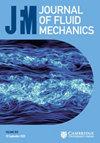拥挤加速了细菌转子的旋转
IF 3.9
2区 工程技术
Q1 MECHANICS
引用次数: 0
摘要
了解一大群个体中游泳者的推进力,是揭示活动物质集体运动的奇妙动力学的关键。在这里,我们开发了一种由细菌鞭毛驱动的二维(2-D)自组装转子。在水气界面上,转子的平均旋转方向是固定的。当手性转子被放入二维细菌悬浮液中时,我们研究了转子角速度的平均值和波动情况。值得注意的是,当周围细菌悬浮液的密度增加时,转子的平均角速度最多会增加 3 倍,而且这种增加是非线性的。在致密的细菌悬浮液中,转子的存在破坏了周围活跃湍流中的涡流,转子的加速度与周围游离细菌的活性水平无关。因此,非线性加速度是流体动力与周围拥挤度相互作用的结果,可以通过流体动力模拟进行定量解释。在活跃湍流中,转子和游离细菌的加速度是同时发生的,这表明拥挤引起的加速度可能会促进不稳定性的发生。这一结果将启发新的基于活性物质的微流体设备,使其具有更好的传输特性。本文章由计算机程序翻译,如有差异,请以英文原文为准。
Crowding accelerates the rotation of a bacterial rotor
Understanding the propulsion of a swimmer in a large group of individuals holds the key to unravelling the intriguing dynamics of active matter collective motion. Here, we develop a two-dimensional (2-D) self-assembled rotor, powered by bacterial flagella. At a water–air interface, the average direction of rotation of a rotor is fixed. When the chiral rotor is put into a 2-D bacterial suspension, we examine the average and fluctuation of the angular velocity of the rotor. Remarkably, the average angular velocity of a rotor is found to increase up to 3 times when the density of surrounding bacterial suspension increases and the increase is nonlinear. In a dense suspension of bacteria, the existence of a rotor disrupts vortices in the surrounding active turbulence, and the acceleration of the rotor is independent of the activity level of the surrounding free bacteria. The nonlinear acceleration thus results from hydrodynamic interaction with surrounding crowdedness that can be quantitatively explained by hydrodynamic simulation. The simultaneity between the acceleration of rotor and free bacteria in active turbulence suggests that crowding-induced acceleration may promote the onset of instability. The result will inspire new active-matter-based microfluidic devices with improved transport properties.
求助全文
通过发布文献求助,成功后即可免费获取论文全文。
去求助
来源期刊
CiteScore
6.50
自引率
27.00%
发文量
945
审稿时长
5.1 months
期刊介绍:
Journal of Fluid Mechanics is the leading international journal in the field and is essential reading for all those concerned with developments in fluid mechanics. It publishes authoritative articles covering theoretical, computational and experimental investigations of all aspects of the mechanics of fluids. Each issue contains papers on both the fundamental aspects of fluid mechanics, and their applications to other fields such as aeronautics, astrophysics, biology, chemical and mechanical engineering, hydraulics, meteorology, oceanography, geology, acoustics and combustion.

 求助内容:
求助内容: 应助结果提醒方式:
应助结果提醒方式:


